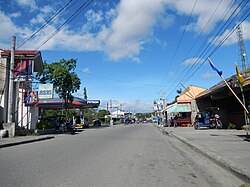Top Qs
Timeline
Chat
Perspective
Rizal, Nueva Ecija
Municipality in Nueva Ecija, Philippines From Wikipedia, the free encyclopedia
Remove ads
Rizal, officially the Municipality of Rizal (Ilocano: Ili ti Rizal; Tagalog: Bayan ng Rizal) is a municipality in the province of Nueva Ecija, Philippines. According to the 2020 census, it has a population of 70,196 people.[5]
This article needs additional citations for verification. (October 2013) |
Rizal is 35 kilometers (22 mi) from Cabanatuan, 49 kilometers (30 mi) from Palayan, 151 kilometers (94 mi) from Manila, and 123 kilometers (76 mi) from Bayombong.
Remove ads
History
Summarize
Perspective
Historically, two groups were known to have settled in the area. The main group consisted entirely of the pioneer-settlers who were Ilocanos, while others, who arrived later, were of different tribes with different dialects. They merged and formed a new neighborhood, originally called Bunobon after the bunobon seedlings that thrived in the soil. It became a sitio of Cabucbucan under the jurisdiction of Bongabon municipality.
In 1904, sitio Bunobon became a barrio called Nazareth. Because of the steady arrival of new settlers, a council of elders was formed. Selected as head was Apo Juliano Paraiso, one of the eldest within the group, who took the lead in requesting that government convert Nazareth into an independent town. Through the help of Governor Manuel Tinio and Assemblyman Isauro Gabaldon, the request of the elders was approved in 1908.
On December 26, 1912, Vice Governor Newton W. Gilbert signed the act and simultaneously issued a proclamation creating the town of Rizal, after Dr. José Rizal. On January 1, 1913, Don Julian Paraiso was inaugurated as the first alcalde of the Municipality. In 1917 and 1918, the Bureau of Land surveyed the municipality for homestead and residential lots. In 1930, Barangay Paco Roman became a barrio, separating it from Barangay Estrella. In 1954, Villa Paraiso was created as a barrio out of barangay Canaan and was named in honor of late Mayor Gaudencio V. Paraiso. In 1959, General Luna officially became a barrio out of barangay Canaan.[6]
In 1954, Rizal lost some of its territory when the barrios of San Felipe and San Alfonso were separated to form the town of Llanera along with some territory from Talavera and San Jose.[7]
In 1963, Villa Pascua was renamed Barangay Pag-asa which is a part of Barangay Agbanawag. In January 1968, Barangay Casilagan became a barrio through Resolution Number 2 of the Provincial Board on January 3, 1968, which was formerly a sitio of Canaan, which was bisected by the Bulalakay Creek, and it was divided into two barrios known as Canaan Este and Canaan Weste. On July 20, 1970, Sanggunian Panlalawigan passed Resolution No. 220 approving the creation of Barangay Maligaya in accordance with Republic Act No. 3590, the area to be taken from the Barangay Bicos and on July 12, 1971, then the Provincial Board Resolution No. 231, Villa Labrador became a Barrio separating it to Villa Paraiso.
Rizal was close to the epicenter of the 1990 Luzon earthquake on July 16.[8]
Remove ads
Geography
Barangays
Rizal is politically subdivided into 26 barangays. Each barangay consists of puroks and some have sitios.
- Agbannawag
- Aglipay
- Bicos
- Cabucbucan
- Calaocan District
- Canaan East
- Canaan West
- Casilagan
- Del Pilar
- Estrella
- General Luna
- Macapsing
- Maligaya
- Paco Roman
- Pag-asa
- Poblacion Central
- Poblacion East
- Poblacion Norte
- Poblacion Sur
- Poblacion West
- Portal
- San Esteban
- San Gregorio
- Santa Monica
- Villa Labrador
- Villa Paraiso
Climate
Remove ads
Demographics

Economy

Poverty incidence of Rizal
10
20
30
40
2000
35.22 2003
19.78 2006
30.20 2009
19.34 2012
18.21 2015
15.21 2018
7.35 2021
13.98 Source: Philippine Statistics Authority[15][16][17][18][19][20][21][22] |
References
External links
Wikiwand - on
Seamless Wikipedia browsing. On steroids.
Remove ads





